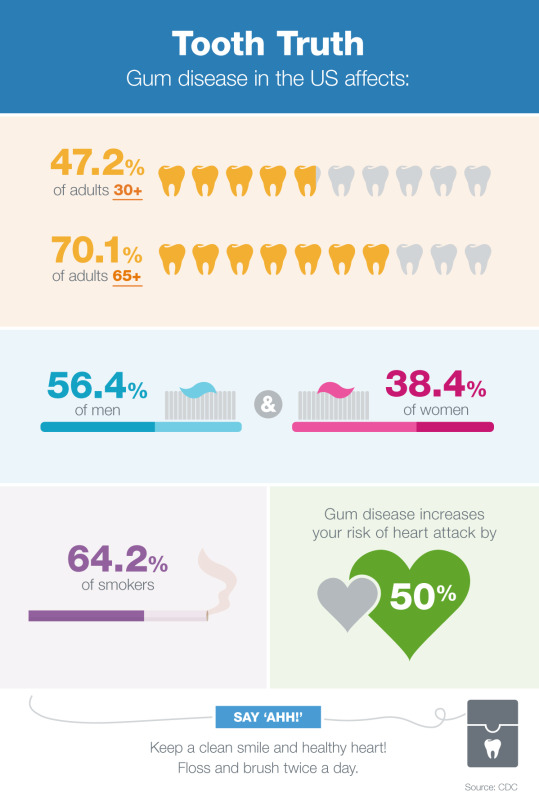
About half of US adults ages
30 and older have some form of gum disease. That number increases significantly
with age.
What causes gum disease?
Gum disease, also known as
periodontal disease, occurs when the tissue supporting your
teeth gets infected. Bacteria, along with mucus and other particles, cover your teeth with a sticky film known as plaque. If you don’t brush and floss often
enough, plaque can harden and become tartar, which that can get stuck to your enamel and can only be removed by a
dental hygienist. The longer plaque and tartar stay on your teeth, the more
likely they are to infect your gums and may cause long-term damage.1
What are the symptoms of gum
disease?
Along with constant bad
breath, symptoms of periodontal disease can include toothache, tooth loss and gums
that are swollen, red, sore or bleed easily.

How can gum disease cause long-term
damage?
Your mouth is full of bacteria,
which can travel into the blood stream, leading to other diseases. One connection of gum disease and chronic health conditions is inflammation—your body’s
natural response to infection or injury. When your gums are infected, inflammatory
substances in the blood can build up and may worsen heart disease, diabetes and
other chronic conditions.
Inflammation is also believed to be a contributor
to heart disease caused by hardening of the arteries, or atherosclerosis.This can reduce blood flow to the heart and put you at greater risk heart
attack or stroke and potentially death.
Am I at risk?
Factors that make someone more likely to have gum disease include age,
smoking, genetics, stress, poor nutrition and other conditions like obesity. Similarly, risks of developing heart disease include smoking, poor
nutrition, lack of exercise, genetics and other conditions like high blood
pressure or cholesterol.
What should I do?
Good heart
health starts by making healthy lifestyle choices such as not smoking, getting
regular exercise, eating a healthy diet and following up with your primary care
physician.
You can also:
- Brush
teeth twice a day with an ADA-accepted fluoride toothpaste. - Clean
between teeth with floss every day. - Eat
a balanced diet and limit sugary snacks. - Visit
your dentist regularly for examinations and professional cleanings.
By Sonali G. Kshatriya, PharmD
Sonali G. Kshatriya is a Pharmacist and Manager in the Department of
Clinical and Quality at Walgreens Co. in Deerfield, IL
Sources
1
NIH: National Institute of Dental and Craniofacial Research. https://www.nidcr.nih.gov/OralHealth/Topics/GumDiseases/PeriodontalGumDisease.htm
2 Harvard Health. http://www.health.harvard.edu/blog/treating-gum-disease-may-lessen-burden-heart-disease-diabetes-conditions-201407237293, accessed 10/14/16.
3 American Heart Association. http://www.heart.org/HEARTORG/Conditions/Inflammation-and-Heart-Disease_UCM_432150_Article.
jsp#.WAUZXY8rJpg, accessed 10/13/16.
4 American Heart Association. http://www.heart.org/HEARTORG/Caregiver/Resources/WhatisCardiovascularDisease/What-is-Cardiovascular-Disease_UCM_301852_Article.jsp#.WAUYv48rJpg, accessed 10/12/16.
5 American Academy of Periodontology.
https://www.perio.org/consumer/risk-factors, accessed
10/12/16.
6 Center for Disease
Control. http://www.cdc.gov/heartdisease/docs/consumered_heartdisease.pdf, accessed 10/12/16.
7 WebMD. http://www.webmd.com/heart-disease/features/periodontal-disease-heart-health#1, accessed 10/12/16.


